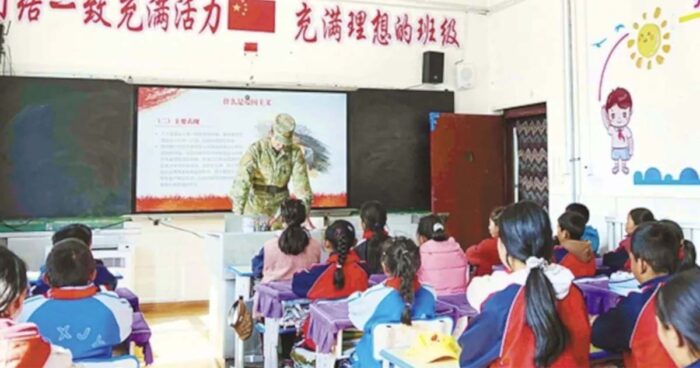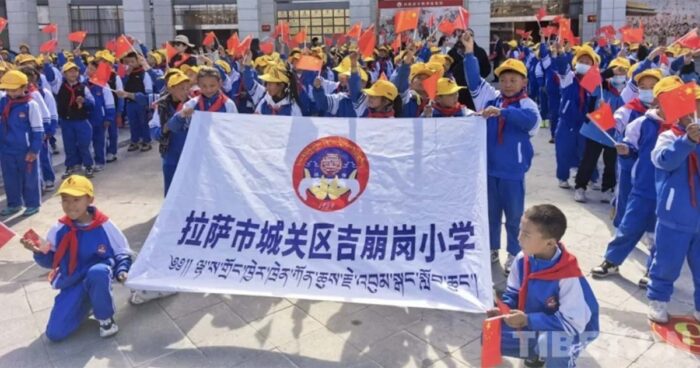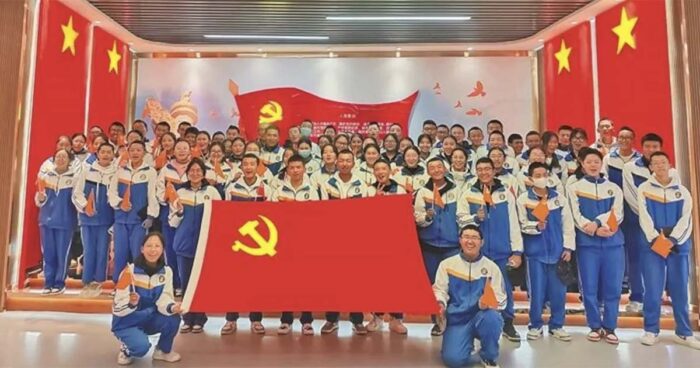The Chinese Communist Party is making enormous efforts to indoctrinate Tibetan schoolchildren with their ideology. Not even primary school pupils escape these ideological campaigns as reports in the Chinese propaganda media show. The indoctrination appears to have two main objectives.
On the one hand, the Communist regime is concerned with so-called “red” re-education, i.e., attempting to inspire children with enthusiasm for the Communist Party and its alleged successes. On the other hand, those in power are trying to cultivate a militant nationalism in schools. Soldiers in uniform give children a type of military training, which is usually linked to nationalist propaganda.
Rapid-fire weapons in the hands of elementary school students
A current example of this is provided by a report from the Chinese propaganda media in the southern Tibetan county of Medog. The accompanying photo (see above) shows a uniformed army veteran “explaining weapon models” to elementary school students, as the report states.

A soldier in uniform conducts “national defense education in school.” (Source: xzxw.com)
The weapon is a modern QBZ 191 rapid-fire rifle, a standard weapon of the communist armed forces. Training with this type of military weaponry is not a part of a normal curriculum for elementary school students.
“Defense education in schools”
According to Communist Party propaganda, military education serves to promote a spirit of “patriotism, love for the border areas, and commitment to their defense and prosperity” among young people in Tibet. In reality, however, it appears the aim is to train Tibetan children to be unconditionally loyal to the Chinese Communist Party.
The program of so-called “defense education in schools” has been in place for some time. Reports on this topic appear repeatedly in the Chinese state media. It is obvious that the militarization of school education in Tibet is intended to prepare children for future military service. And incidentally, the program also aims to “pass on the red gene” to Tibetan elementary school students.

Fourth graders pose for a photo for the state media. Their banner reads “Jibenggang Primary School in Chengguan District, Lhasa.” (Source: xzxw.com)
Fourth graders at the Mao Museum: “Passing on the red heritage”
In another case of indoctrination, the ideological influence on the students was clearly the focus. A report by the Chinese state media about a visit by fourth graders to the Mao Badge Museum in Lhasa makes no secret of this.
The school trip was held under the motto “Passing on the red heritage and strengthening the sense of community of the Chinese nation.” The “immersive learning experience” pressed the young people to “internalize the red culture,” according to the propaganda rhetoric. The cooperation between the school and the museum is intended to further promote the “patriotic education” of young people.

The Mao Museum is a permanent fixture in the context of ideological re-education in Tibet. (Source: xzxw.com)
A museum entirely dedicated to the worship of the communist dictator
The Mao Museum is a permanent fixture in the program of ideological re-education in Tibet’s schools. The museum, entirely dedicated to the worship of the communist dictator, opened in Lhasa just a few years ago. It displays a large number of so-called Mao pins, billions of which were in circulation at the height of the Mao cult during the terrible years of the Cultural Revolution.
The exhibition also presents key events in “Chinese revolutionary history,” which are all pure Communist Party propaganda.
The Communist Party’s policies, as outlined in this report, aim to indoctrinate Tibetan students, prepare them for military service, and effectively cut off ties to their Tibetan heritage, language, and in many cases, their family. Beijing’s actions violate the basic human rights of Tibetans, including allowing them to live their lives, speak their language, and practice their religion as they see fit. The international community must urgently hold China accountable for its disturbing and egregious treatment of Tibetan children, and the Tibetan people as a whole.